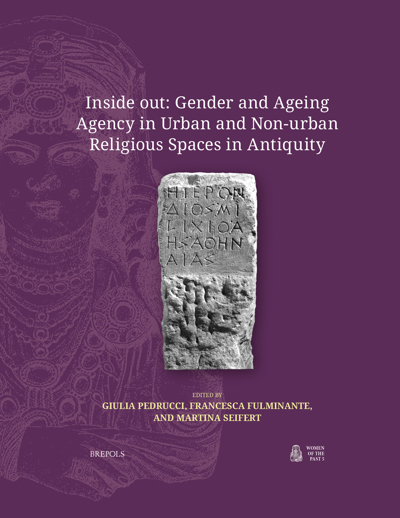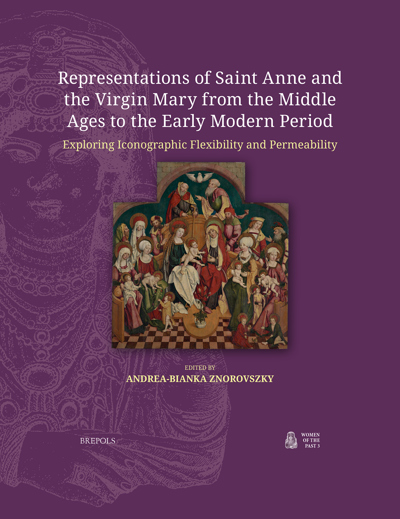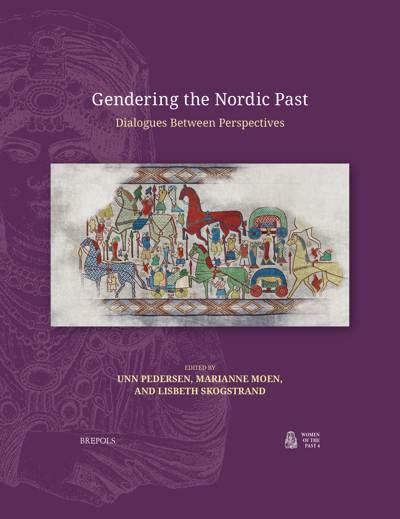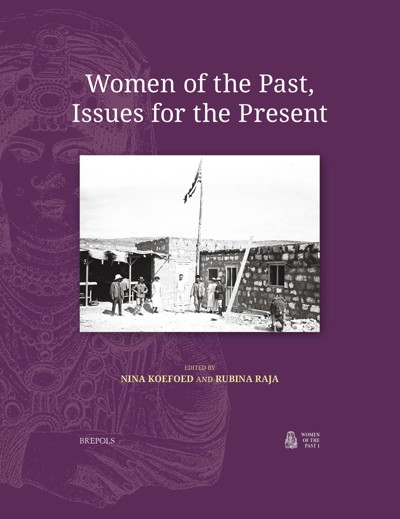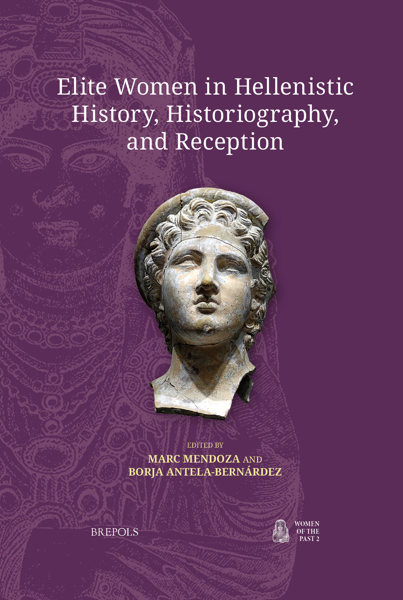
Inside out: Gender and Ageing Agency in Urban and Non-urban Religious Spaces in Antiquity
Giulia Pedrucci, Francesca Fulminante, Martina Seifert (eds)
- Pages: approx. 416 p.
- Size:216 x 280 mm
- Illustrations:60 b/w, 50 col.
- Language(s):English, Italian
- Publication Year:2026
- € 155,00 EXCL. VAT RETAIL PRICE
- ISBN: 978-2-503-61706-0
- Hardback
- Forthcoming (May/26)
- € 155,00 EXCL. VAT RETAIL PRICE
- ISBN: 978-2-503-61707-7
- E-book
- Forthcoming
*How to pre-order?
Inside out investigates Women and Children in Urban and Non-urban Sanctuaries and Funerary Contexts in Antiquity to elucidate the effects of Gender and Ageing Agency on Urbanity and Religion in Past Populations and recognize the role of Women and Children in shaping Social, Economic, and even Political Relations, often prerogative of Higher status, Aristocratic Males.
Giulia Pedrucci is adjunct professor at the University of Verona where she teaches History of religions. She is an international high-profile scholar; she was a Gerda Henkel scholar and, previously, a Marie Curie co-fund fellow. She has written several monographs and scientific articles.
After several Post-docs at excellent European institutions, Francesca Fulminante is now teaching classical civilizations in the UK and Italy. She has contributed to projects and excavations at major Pre-Roman and Roman sites in Italy and UK. She disseminated extensively, both academically and publicly, on the urbanization of Central Italy within the Mediterranean during the first Millennium BC, on a wide range of topics from funerary and settlement analysis to transportation networks to infancy and gender issues.
Martina Seifert is Professor and Director of the Institute for Archaeology and Ancient History of the Mediterranean at the University of Hamburg. She is also Prodecan for the Internationalization and Promotion of young Talents of the Humanities Faculty. She specializes in theory and methods of archaeology, visual culture, religion, settlement archaeology and modern techniques like geophysics and archaeometry.
Religious spaces in Antiquity could be urban (located in a densely populated area), suburban (within a day’s walk of the city), or even extra-urban (located far outside the city walls, and away from the hustle of densely populated areas). They also served very different purposes, with urban sanctuaries often serving local socio-political dynamics, while extra-urban spaces were often founded to allow meditation — or for the exercise of political control over a particular territory. But while the importance of different religious spaces has long been known, up to now, very little attention has been paid to the activities of women and children within these religious spaces. This volume aims to investigate the role that these actors played in Antiquity, both in urban and non-urban sanctuaries and in funerary contexts, in order to see how they fitted into this sacral environment, and in turn, how such sanctuaries were shaped by their presence. Different chapters within the volume explore key questions such as: can religious experiences shape urban landscapes? can urban space influence religious experiences and activities? and what role did women and children play in shaping and linking religious activities and spaces? The result is a far-reaching volume that seeks to recognize the hitherto unrecognized role of women and children in shaping the social, economic, sacral, and even political landscapes of sacred spaces.
List of Illustrations
Introduction
Giulia Pedrucci, Francesca Fulminante, and Martina Seifert
1. Spazi della morte e infanzia: Riflessioni a partire dalla documentazione archeologica nell’Italia preromana
Daniela Costanzo
How Urban, Non-Urban, and Funerary Spaces Intertwine with Women and Children: General Remarks and ‘Interspazial’ Perspectives
2. Infancy and Archaeology in Sacred Areas in Etruria
Elisabetta Govi
3. The Infancy of Dionysus and the Sacred: Evidence between Etruscan Bologna and Vulci
Chiara Pizzirani
4. Distribuzione e funzione delle statuette votive fittili raffiguranti adulti con bambini nell’Italia antica fra VII e I secolo a.C.: differenze fra spazi urbani, non urbani e funerari
Giulia Pedrucci
5. Le statuette votive fittili raffiguranti adulti con bambini nell’Italia antica e lo spazio. Tre casi di studio a confronto: il cosiddetto tempio di Minerva Medica a Roma, il santuario di Fondo Patturelli a Capua e il santuario di Bitalemi a Gela
Giulia Pedrucci
6. Religious Agency of Children and Youths in the Roman Greece of Pausanias
Ville Vuolanto
Urban and Suburban Spaces
7. Women and Female Deities in the Urban and Suburban Sanctuaries of Pompeii
Maria Teresa D’Alessio
8. ‘Worshipping Women’. Case Studies from Urban and Suburban Holy Places in Southern Apulia (Sixth-Third Century BC)
Giovanni Mastronuzzi
9. Megara Hyblaea. Culti nel santuario sul porto: Donne e bambini nelle aree sacre e nelle necropoli della città
Lorenzo Guzzardi
10. Donne e bambini nel santuario urbano di Griso Laboccetta a Rhegion: Immagini, offerte, praxis rituale
Daniela Costanzo
11. A Religious Space for Female Performances in the Context of Meter Cults: An Epigraphic Survey from the Hellenistic to the Imperial Period
Marios Kamenou
12. Women and their Clothing Styles in Sacred Spaces: The Case of Palmyra
Olympia Bobou and Rubina Raja
Extra-urban Spaces
13. Back to Brauron: Hippocrates, Artemis, and Girls in Extra-urban Sanctuaries
Laurence Totelin
14. Female Offerings and Slf-representation in Mid-republican Votive Deposits. A Case Study from Fidenae
Letizia Ceccarelli
15. La munificenza femminile nei luoghi di culto dell’Italia Romana: alcuni esempi
Silvia Gazzoli
16. ‘Empty spaces’. The Rejection of Motherhood in Female Ascetic Contexts of Late Antiquity, with Reference to Syriac Linguistic and Cultural Environments
Claudia Tavolieri
17. Engaging with the World of the Medieval Anchoress in the Twenty-First Century
Emily Bowyer-Kazadi
Funerary Spaces
18. Motherhood (and by Comparison Fatherhood) Indicators in Funerary Ritual Spaces in Proto-historic Central Italy (Latium vetus and Osteria dell’Osa 1100/1050–580 BC)
Francesca Fulminante
19. Women and Infants in Urban Funerary Sacred Spaces in Campania
Mariassunta Cuozzo
20. Iulia Florentina’s Burial in Catania: Urban and Suburban Religious Spaces in Connection
Cristina Soraci
21. Saint Agatha’s Burial in Catania: New Discoveries
Cristina Soraci
22. Women and Children in Funerary Practices in the Cemetery of Vaste (Fourth–Sixth Century AD): A Visible Care for Invisible People
Giovanni Mastronuzzi and Giorgia Tulumello
